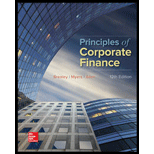
Concept explainers
True/false True or false?
- a. All stocks in an equivalent-risk class are priced to offer the same expected
rate of return . - b. The value of a share equals the PV of future dividends per share.
a)
To discuss: Whether the statement is true or false.
Explanation of Solution
Given statement:
Mostly all the stock which have same equivalent risk are always priced to provide similar expected rate of return.
Justification:
The given statement is true all the stocks which have equivalent risk are priced to provide similar expected rate of mainly the market risk.
Hence, the statement is true.
b)
To discuss: Whether the statement is true or false.
Explanation of Solution
Given statement:
Value of a share is equal to the present value of future dividend per share
Justification:
It is true that value of a share is equal to the present value of future dividend per share
Hence, the statement is true.
Want to see more full solutions like this?
Chapter 4 Solutions
Principles of Corporate Finance (Mcgraw-hill/Irwin Series in Finance, Insurance, and Real Estate)
- What is a characteristic line? How is this line used to estimate a stocks beta coefficient? Write out and explain the formula that relates total risk, market risk, and diversifiable risk.arrow_forwardAssume that Temp Force has a beta coefficient of 1.2, that the risk-free rate (the yield on T-bonds) is 7.0%, and that the market risk premium is 5%. What is the required rate of return on the firms stock?arrow_forwardCalculate the correlation coefficient between Blandy and the market. Use this and the previously calculated (or given) standard deviations of Blandy and the market to estimate Blandy’s beta. Does Blandy contribute more or less risk to a well-diversified portfolio than does the average stock? Use the SML to estimate Blandy’s required return.arrow_forward
- You are examining three different shares. Share A has expected return -0.30%, beta -0.49, and volatility 29.00%. Share B has expected return 9.80%, beta 1.09, and volatility 24.00%. Finally, share C has expected return 8.60%, beta 0.88, and volatility 13.00%. The risk free rate is 2.70%, while the market price of risk is 7.00%. According to the CAPM, which share is undervalued?arrow_forwardAssume you know the expected and required rate of returns of the following stocks. Explainwhich of the following stocks are undervalued, overvalued and fairly valued. Stock Expected rate of return Required rate of return Evaluation X 10 12 ? Y 6 5 ? Z 4 4 ?arrow_forward
 Intermediate Financial Management (MindTap Course...FinanceISBN:9781337395083Author:Eugene F. Brigham, Phillip R. DavesPublisher:Cengage Learning
Intermediate Financial Management (MindTap Course...FinanceISBN:9781337395083Author:Eugene F. Brigham, Phillip R. DavesPublisher:Cengage Learning EBK CONTEMPORARY FINANCIAL MANAGEMENTFinanceISBN:9781337514835Author:MOYERPublisher:CENGAGE LEARNING - CONSIGNMENT
EBK CONTEMPORARY FINANCIAL MANAGEMENTFinanceISBN:9781337514835Author:MOYERPublisher:CENGAGE LEARNING - CONSIGNMENT
 Pfin (with Mindtap, 1 Term Printed Access Card) (...FinanceISBN:9780357033609Author:Randall Billingsley, Lawrence J. Gitman, Michael D. JoehnkPublisher:Cengage Learning
Pfin (with Mindtap, 1 Term Printed Access Card) (...FinanceISBN:9780357033609Author:Randall Billingsley, Lawrence J. Gitman, Michael D. JoehnkPublisher:Cengage Learning





